New Ford Focus vs Golf, Astra and Pulsar
The best-selling family hatchbacks under the microscope
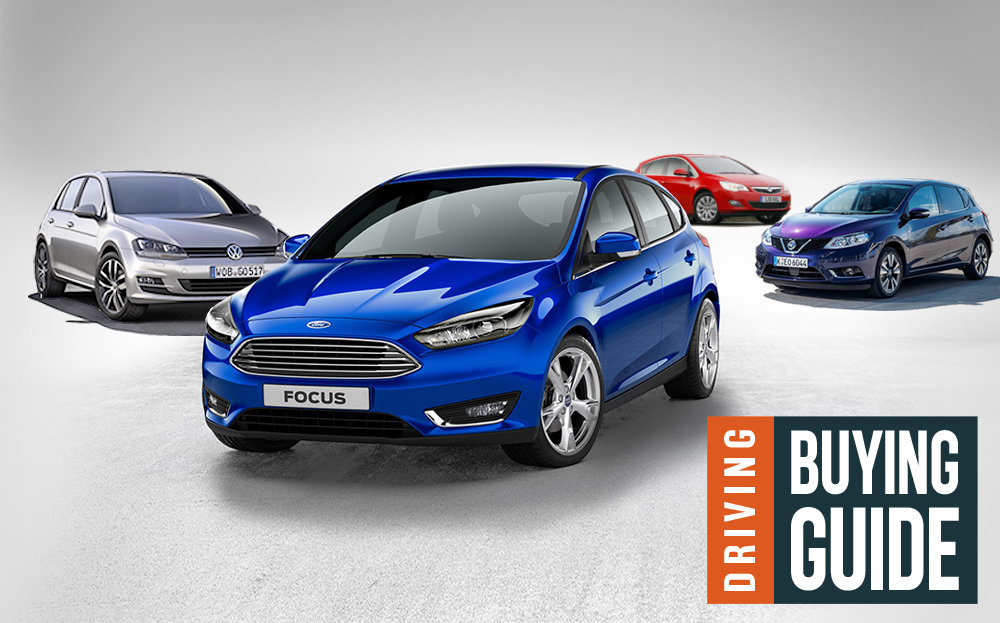
THE FORD Focus has just undergone a touch of cosmetic surgery (and a bit of work under the bonnet, too) to keep it young and beautiful. If that’s the key to being loved, as the old Eddie Cantor song goes, it should help the trusty Focus to stay at ‒ or at least near ‒ the top of the pile when it comes to mid-size hatchbacks. It was the UK’s best-selling small family car last year, don’t you know.
But if you’re considering buying one when it goes on sale in November, no doubt you’ll also be looking at the Volkswagen Golf, too, so it’s worth comparing the two in detail. Rather than expect you to do the donkey work, we’ve done it for you in this handy guide.
We’ve also added the Vauxhall Astra, which was the second best-selling small family car last year, slightly ahead of the Golf in third place. We’ve added a wildcard to the mix, too: the Nissan Pulsar. It goes on sale in November (the same time as the new Focus) and is the Japanese car maker’s first mid-size hatchback since the Almera. Nissan has had great success with the Juke and Qashqai, so it’s worth checking out the car they hope will take sales away from the Golf, Astra and all-conquering Focus.
– Jump to –
Pricing | Design | Interior | Engines | The drive | Tech & gadgets | Conclusion
—
Pricing
Buying a Ford usually means not having to shell out a fortune but with the brand continuing to improve the quality of materials, fit and finish, prices might not be as “bargain basement” as you expect. The new Focus will be in showrooms in November starting at £13,995 for the most basic Studio model with a 1.6-litre 84bhp petrol engine.
The most affordable Golf, on the other hand, will set you back £16,975, which gets you the same sort of performance, so the VW badge still costs a premium.
Don’t know your BHPs from your MPVs? Click to take a look at our car jargon buster
The cheapest model in our group is the Vauxhall Astra: you can pick up a 1.4-litre Expression model for just £12,995, and that buys you an extra 14bhp.
Meanwhile, our wildcard, the Pulsar, will cost from £15,995 for the entry-level Visia model with a 1.2-litre engine producing 113bhp.
Of course, trim levels will differ between the cars (the Ford Focus Studio is pretty devoid of luxuries and tech, whereas even the most basic Golf has a 5.8in colour touchscreen and DAB radio) so for a fairer comparison in the table below, we’ve looked at prices for models that offer similar sorts of specification and power.
Comparable specification models in price order:
| Vauxhall Astra Excite 1.6i 16v VVT 115 5dr | Nissan Pulsar n-tec 1.2 DIG-T 115 5dr | Ford Focus Titanium 1.0T EcoBoost 100PS 5dr | Volkswagen Golf Match 1.4 TSI BMT 122 5dr |
| £18,600 | £18,995 | £19,795 | £20,335 |
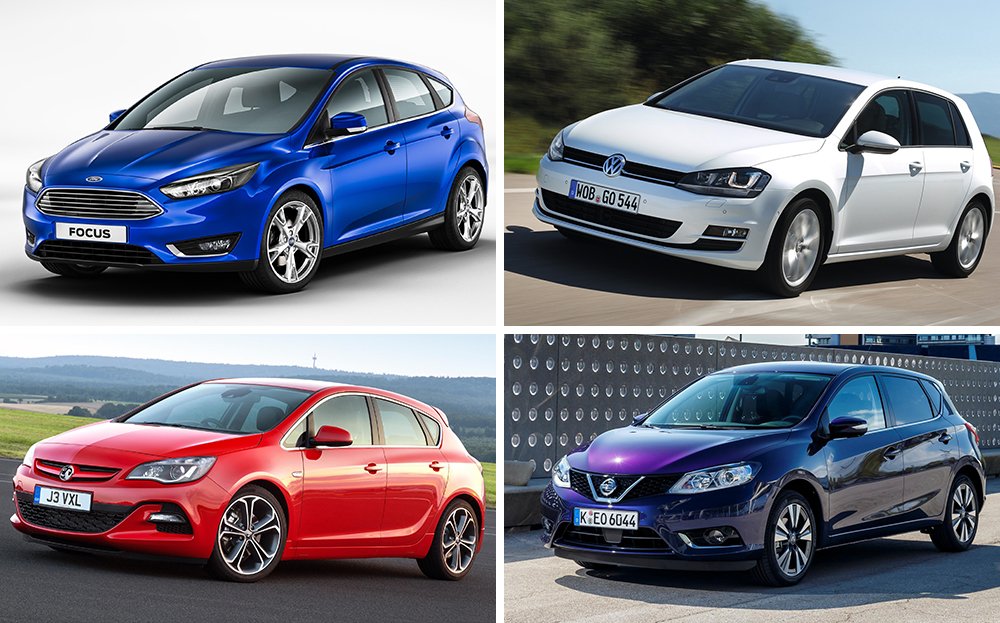
Design
The mid-size hatchback market is never going to set the world alight in terms of styling. This is a conservative segment, style-wise, and buyers tend to go for cars that don’t rip up the design rulebook. Tried and tested is the key. Which is why they tend to look very similar to one another. Take a look at the side windows of the Focus and Astra, for example.
That said, our four contenders do show glimpses of flare. Ford’s tweaks to the Focus occur mainly at the front, with the nose now adopting the brand-wide, upside-down trapezoid grille. The sharp lines along the bonnet are not unattractive, either, and the flared wheel arches lend the car a vaguely aggressive stance. The rear end, in Driving’s opinion, is the best-looking of the lot.
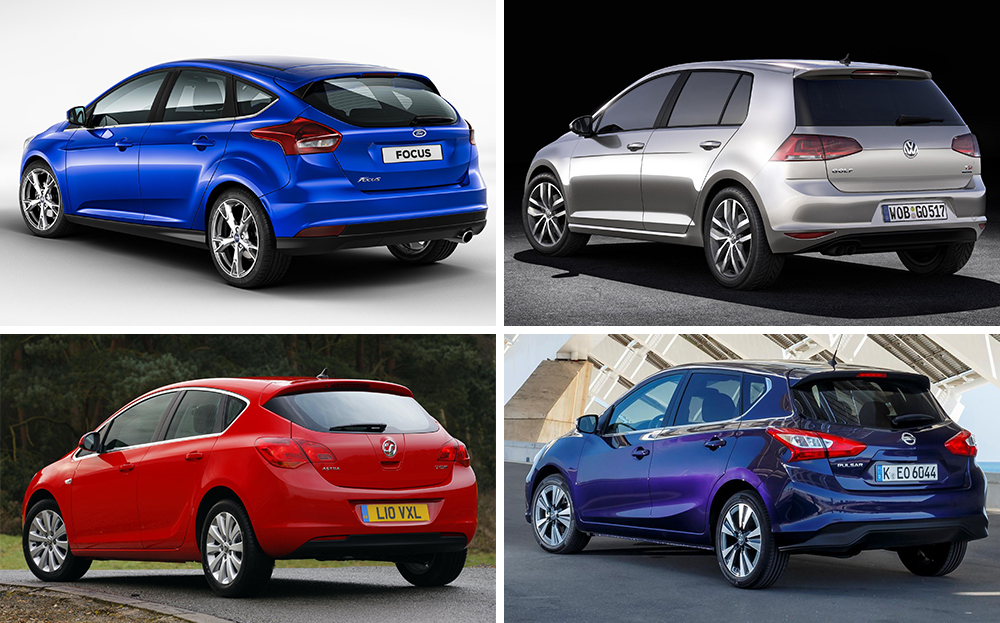
The Astra is the oldest of the bunch ‒ expect a major update next year ‒ but it was a forward-thinking design when launched and has perhaps the sportiest look of our group. The Golf, meanwhile, has the most grown-up appearance with a squarer profile. It’s not the most interesting looking but it is, we’d suggest, still the classiest option in this segment.
Nissan has attempted to create some interesting, swooping lines on the Pulsar ‒ for example on the bonnet and above the door handles ‒ but we think it’s the least attractive overall design.
Interior
Climb inside and there’s no question, the Golf has the other models licked in terms of quality and design. Its touchscreen is standard across the range, too, whereas the new Focus only gets its Sync2 high-resolution touchscreen in Titanium trim and upwards (more on this below). If you go for Titanium or Titanium X Focus, though, the quality of materials is not far off the Golf, and the layout is leagues ahead of the outgoing model.
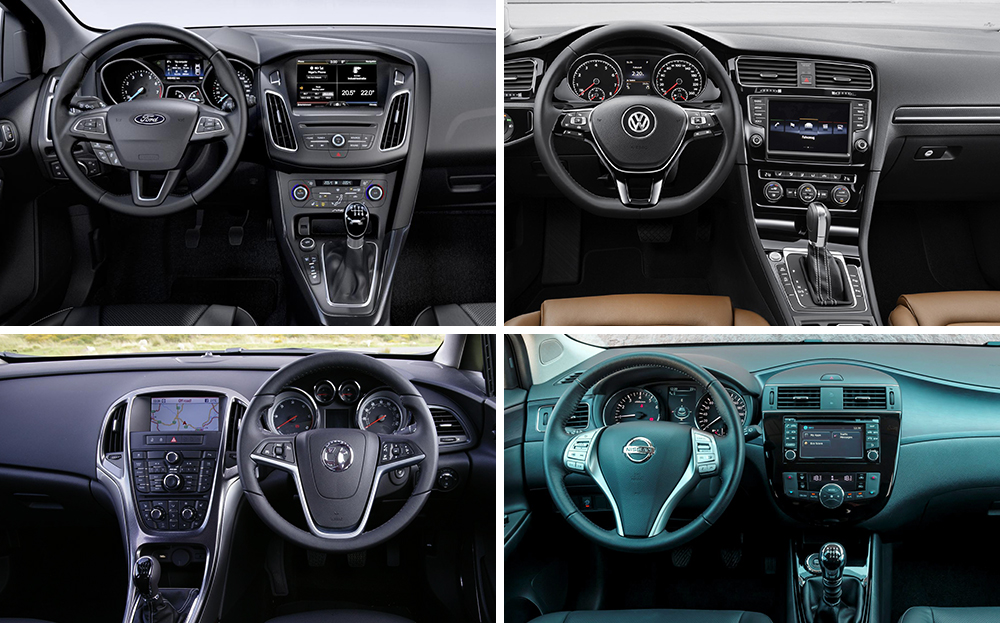
The main criticism of the Golf is that the screen is quite low down in the centre stack, drawing the driver’s eye too far from the road. The Pulsar suffers from the same problem and its screen is too small, while the switchgear of both the Pulsar and the Astra is too plasticky to compete with the Focus and Golf.
We’ve yet to get the tape measure out on the rear of the new Focus and Pulsar to check the space available to passengers but as a rough guide, the previous Focus and Astra were very similar while the Golf has a slight edge in legroom, if not headroom. In all cases, it pays to be less than 6ft tall if you’re travelling in the back of a mid-size hatch.
What we can do is address the exciting topic of boot space… Pulsar wins.
| Ford Focus | Vauxhall Astra | Volkswagen Golf | Nissan Pulsar | |
| Length (mm) | 4358 | 4419 | 4255 | 4387 |
| Width (mm) | 2010 | 2013 | 2027 | 2017 |
| Height (mm) | 1484 | 1510 | 1452 | 1520 |
| Luggage space (litres) | 363 / 1148* | 351 / 1216* | 380 / 1270* | 385 / 1395* |
* With rear seats folded
Engines
Increasingly in the family hatchback class, if a manufacturer’s car doesn’t fall into road tax class A (CO2 output of less than 100g/km) or B (101-110g/km) it might as well box it up and send it back to the factory.
Not surprisingly, the Focus facelift has given Ford the excuse it needed to add a new, scrupulously clean 1.5 TDCi diesel engine to the model mix. It produces 118bhp and 199lb ft torque but, more impressively, 74.3mpg and 98g/km.
It, and the two existing 1.0T EcoBoost petrols (up to 61.4mpg and 105g/km), will be the best sellers. We’ve not driven the diesel but the 1.0T EcoBoost 125PS petrol engine is surprisingly punchy, quiet and a good, smooth cruiser.
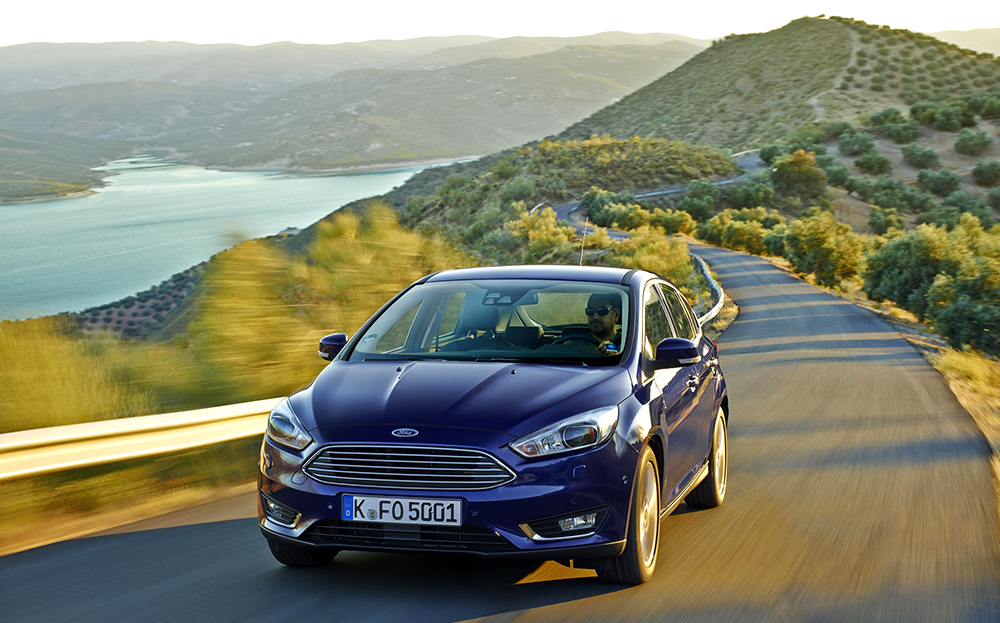
Likewise, Vauxhall will use the opportunity presented by next year’s all-new Astra to present new, cleaner engines including a three-cylinder petrol to rival Ford’s EcoBoost. Until then, however, it soldiers on with a range of efficient diesels (the 1.6 CDTi 110ecoFLEX, for example, produces 97g/km, 76.3mpg and a whopping 221 lb ft torque) but dirtier petrols including the 1.6 VVT 115PS which puffs out a choking 147g/km (tax class F), though a more wallet-friendly 55.4mpg. Surprisingly for a fleet-favourite such as the Astra, this petrol unit is the best-selling engine in the range.
In contrast, the best-selling Golf by a country mile (85% of total sales) is powered by a 1.6-litre TDI diesel engine that produces 99g/km and 74.3mpg. As is the way with VW Group diesels, it’s a discreet, sophisticated and punchy motor, lively on the throttle and capable of a near-silent cruise. The 1.4 TSI petrol (120g/km) looks a little “dirty” not only compared with its Golf diesel sibling but also with the Focus’s ultra-efficient 1.0T EcoBoost 125PS but it, too, is a pleasure to drive.
Search for and buy your next car on driving.co.uk
The Nissan Pulsar is the latest all-new car in the class, a fact apparent in the 1.5dCi’s squeaky-clean 94g/km emissions and impressive 78.5mpg consumption. Both figures shade the Focus’s new 1.5 TDCi. Ford gets its own back with its 1.0T EcoBoost 125PS, which is cleaner than the Pulsar’s 1.2 DIG-T. However, the 1.2 DIG-T is our pick of the Pulsar range, despite its class-C tax status.
Diesel equivalents in order of economy
| Engine | Focus 1.5 TDCi 120PS | Golf Match 1.6 TDI 105 PS | Astra 1.6 CDTi 110 ecoFLEX | Pulsar 1.5 dCi 110PS |
| Power | 118bhp | 104bhp | 108bhp | 108bhp |
| Torque | 199 lb ft | 184 lb ft | 221 lb ft | 192 lb ft |
| Economy | 74.3mpg | 74.3mpg | 76.3mpg | 78.5mpg |
| CO2 emissions | 98g/km | 99g/km | 97g/km | 94g/km |
| Acceleration | 0-62mph in 9.2sec | 0-62mph in 10.7sec | 0-62mph in 11.4sec | 0-62mph in 11.5sec |
| Top speed | 120mph | 119mph | 115mph | 115mph |
Petrol equivalents in order of economy
| Engine | Golf Match 1.4 TSI 122PS | Astra 1.6 VVT 115PS | Pulsar 1.2 DIG-T 115 | Focus 1.0T EcoBoost 125PS |
| Power | 120bhp | 113bhp | 113bhp | 123bhp |
| Torque | 148lb ft | 114lb ft | 140 lb ft | 125 lb ft |
| Economy | 53.3mpg | 55.4mpg | 56.5mpg | 60.1mpg |
| CO2 emissions | 120g/km | 147g/km | 117g/km | 108g/km |
| Acceleration | 0-62mph in 9.3sec | 0-62mph in 10.9sec | 0-62mph in 10.7sec | 0-62mph in 11sec |
| Top speed | 126mph | 118mph | 118mph | 120mph |
The drive
All new cars are developed within an inch of their life, but buyers (families and hard-nosed fleet managers) who shop in this sector enjoy some of the best developed of all. No model can afford to be dull, especially at the wheel.
Sixteen years after the original, the Focus continues to impress. With its quick steering, fun handling and eager engines, it’s a driver’s car. But it’s kind on passengers, too, with a ride that is supple and forgiving. It hasn’t quite the mature, absorptive quality of a Golf, but it’s getting there.
What the Astra lacks in sparkle it makes up for with an all-round competency. As we saw in its role as Top Gear’s Reasonably Priced Car, it has grippy, well-sorted handling. It offers a smooth, stable ride, perfect for those endless motorway miles, too. Next to the pointy Focus, it’s the understated one but ultimately just as rewarding.
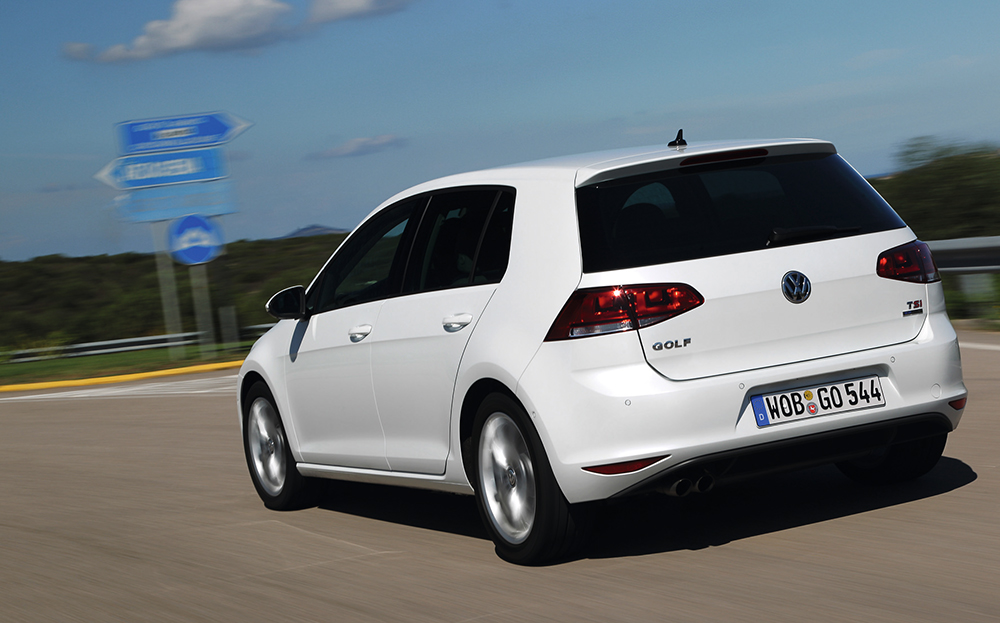
The Golf’s trick is to combine these two cars’ virtues in one. With a lively engine such as the 1.4 TSI under the bonnet, it has the spirit to bring a smile to your face, and the handling to match. However, its ride has a depth and sophistication that, ultimately, eludes the Focus but reminds you, a little bit, of the Astra. It’s quiet, refined and capable of taking extreme punishment, as generations of past owners know only too well.
The new Nissan Pulsar isn’t out to win any prizes for best driver’s car. Its objective is simply to establish itself quickly as a credible player on all fronts, rather than a star on one. So its handling is neutral and predictable, and its steering light, with a tendency not to self-centre.
Its ride, however, is easily disturbed on broken surfaces. As we’ve seen, the diesel is very economical (78.5mpg) but noisy and makes the car nose-heavy. The 1.2 petrol is our pick for its willing nature and smooth but sprightly ways.
Read the reviews:
Technology and gadgets
The technology arms race is well underway in this class with the freshest models each raising the bar in terms of what buyers can expect.
Pulsar
The new Pulsar veritably pulses with toys, although inevitably, it’s the higher trim levels that benefit the most. Standard features include digital radio and elements of Nissan Safety Shield, a 5in colour display and safety aids such as Active Trace Control, which brakes the inside wheels to avoid you deviating from your steered path in fast cornering.
Higher-spec Pulsars include features such as Forward Emergency Braking as well as a reversing camera (with optional 360-degree visibility), smartphone integration, Google “Send to Car” journey planner and Park Assist (which, as the name suggests, parks the car for you).
Astra
Though getting on now, the current Vauxhall Astra still manages to offer some seriously smart safety and driver-assistance kit, though much of it is available only in the form of option packs on models higher up the range. There is no touchscreen in the line-up and even digital radio is an option on most models.
There are two safety and driver assistance packs offered as options. Pack One includes a rear view camera, Xenon lights, and forward collision and lane departure warning but it’s only offered on Tech Line and above, while a second pack features cruise control and forward distance indicator but is an option on top-spec models only. A Perimeter Protection pack includes advanced park assist and blind spot alert. In short, you have to study the specification and options sheets very carefully to be sure your Astra has exactly what you want.

Focus
Part of the new Focus’s brief was to tidy up the fascia by clearing away all the old buttons and in their place, offering the driver touchscreen control of most functions. In fact, only Titanium trim levels and upwards benefit from the new, integrated 8in touchscreen. If you splash out on it, the Sync 2 system includes voice control, which allows the driver to make hands-free calls, speak destinations to the sat nav and choose what to listen to.
Lower-spec cars get the old-generation’s 4.2in display screen and less sophisticated voice control, along with all the old buttons, while entry-level Studio is in the Dark Ages with a 3.5in screen and no voice control at all.
Meanwhile, as you go up the range, as many as 18 advanced driver-aid technologies including adaptive lighting, Cross Traffic Assist and pre-collision assist emerge.
Golf
The Golf’s quiet maturity extends to its technology which, while not brimming with the latest flashy 360-degree visibility package or voice control system, is well chosen and, more importantly, fitted as standard across pretty much the whole range. Every model has a digital radio, Bluetooth and a 5.8in touchscreen.
All models above the entry-level S trim have automatic distance control, adaptive cruise control, Driver Alert (which monitors the driver’s concentration levels), stability control and parking sensors. In addition, Brake Assist and automatic post-collision braking, which applies the brakes to avoid a secondary impact, is standard across the range. It all adds up to a sensible and intelligent roster of essential kit.
Conclusion
There are many reasons to buy the new Ford Focus when it hits showrooms in November: more sophisticated styling, class-leading handling, superb new engines and competitive pricing. On the face of it, the Focus looks like great value when compared with the Golf.
However, look closely at the specifications and you realise VW offers a lot of extra kit as standard. And if you want the Ford’s touchscreen, which is a standard feature across the Golf range, you’ll need to go for the Titanium grade and above, which nudges the price near enough to an equivalent Golf as to not make a huge difference. Of note, too, is that the VW badge will help the car retain more of its value over time than the Ford’s.
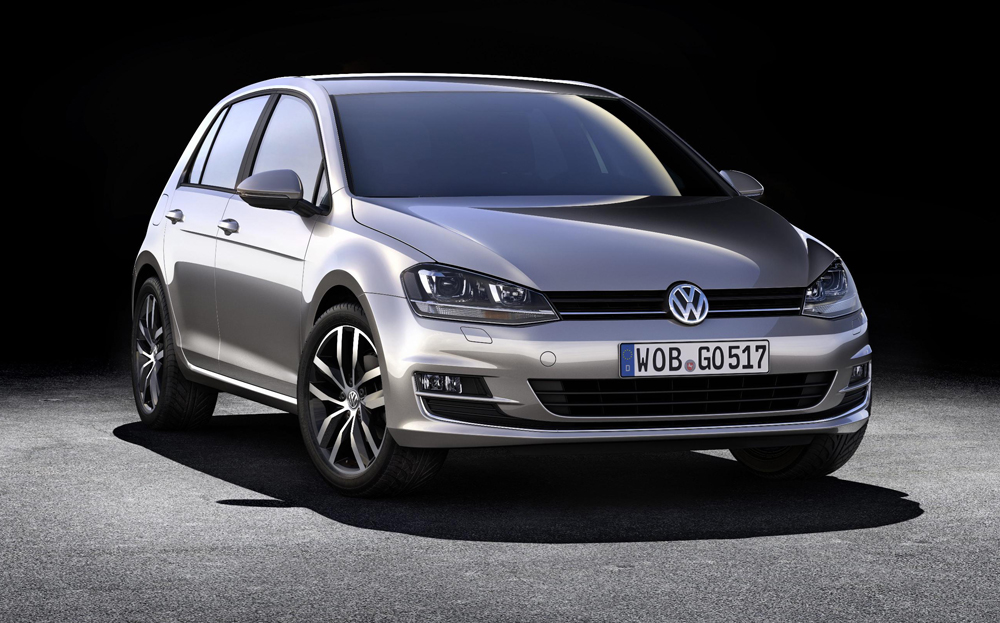
The Astra is a good car: fun to drive and competitive where it counts, particularly on price. However, the options list is long and you could end up over specifying and paying too much for a car that really is beginning to show its age, particularly on the inside. The quality is also a step below both the Ford and the VW.
The new kid on the block, the Nissan Pulsar, packs plenty of tech but its styling is too dull, inside and out, and doesn’t do enough to take the fight to the competition in any particular area. On the plus side, it is a surprisingly decent drive and has a brilliantly economical diesel engine.
The one to buy
Volkswagen Golf Match 1.6 TDI BMT 105 5dr, £21,190
Find one used or nearly new on driving.co.uk: click here
Search for and buy your next car on driving.co.uk
—
Don’t know your BHPs from your MPVs? Click to take a look at our car jargon buster




